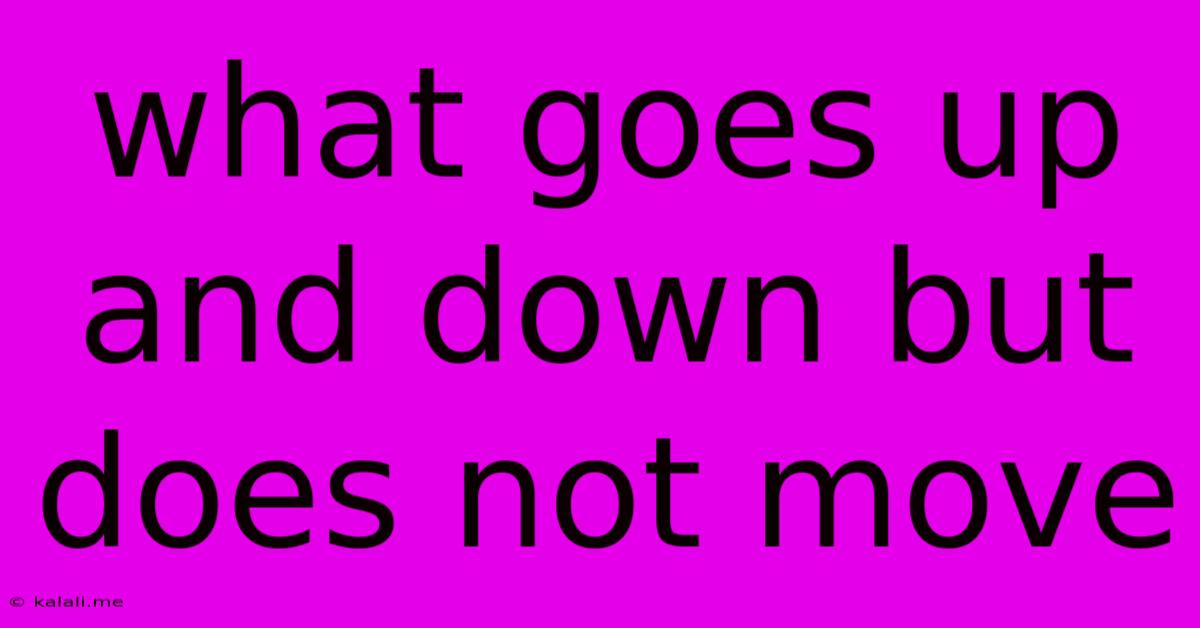What Goes Up And Down But Does Not Move
Kalali
May 20, 2025 · 3 min read

Table of Contents
What Goes Up and Down But Doesn't Move? The Answer and More Word Puzzles
This age-old riddle, "What goes up and down but doesn't move?", has stumped many, sparking curiosity and a playful challenge. The answer, of course, is temperature. But let's delve deeper into why this is the answer and explore some other fascinating word puzzles that tap into our lateral thinking skills. Understanding the structure of this riddle will help you better approach other similar brain teasers.
This riddle relies on a play on words, focusing on the dual meaning of "goes up and down." We don't typically think of temperature as something with physical movement; instead, it's a measurement that changes. This is a clever way to trick the brain into looking for a physical object. Mastering riddles like these hones our ability to think outside the box, and understanding the various linguistic mechanisms employed makes us better problem-solvers.
Understanding the Riddle's Structure: A Key to Solving Other Puzzles
The riddle uses ambiguity—the intentional use of words with multiple meanings—to create its puzzle. The phrase "goes up and down" can refer to both physical movement and a change in value. This ambiguity is crucial to the riddle's effectiveness. Other riddles often employ similar techniques, such as:
- Double meanings: Words or phrases with two distinct interpretations.
- Metaphors and similes: Figurative language that adds layers of meaning.
- Wordplay: Clever use of words and their sounds.
To master similar brain teasers, focus on identifying these linguistic devices. Look for words that might have multiple meanings, consider figurative interpretations, and be prepared for unexpected twists.
More Brain Teasers to Sharpen Your Mind
Here are a few more word puzzles to test your lateral thinking skills:
- What has an eye but cannot see? (A needle)
- What is full of holes but still holds water? (A sponge)
- What has no voice but can still tell you stories? (A book)
These riddles, like the original, rely on unexpected interpretations of common words and concepts. Try to identify the key linguistic techniques being used to uncover the solutions.
The Importance of Lateral Thinking
Solving these types of riddles cultivates valuable cognitive skills, including:
- Creative problem-solving: Thinking outside the box and exploring multiple perspectives.
- Critical thinking: Analyzing information and identifying hidden clues.
- Enhanced vocabulary: Expanding understanding of word meanings and nuances.
Regular practice with word puzzles like these can significantly improve your cognitive flexibility and problem-solving abilities. So, keep challenging yourself! You might be surprised at how much your brain can adapt and grow.
Conclusion: Beyond the Answer
The riddle, "What goes up and down but doesn't move?", is more than just a simple question with a single answer. It's a gateway to understanding the power of language, the importance of lateral thinking, and the sheer enjoyment of a good brain teaser. So, the next time you encounter a similar puzzle, remember the techniques discussed here – and get ready to be challenged and entertained.
Latest Posts
Latest Posts
-
How Does Brita Filter Sensor Work
May 21, 2025
-
No Video Supported Format And Mime Type Found
May 21, 2025
-
Can A Rabbi Marry A Non Jew
May 21, 2025
-
Do You Integrate Acceleration To Get Velocity
May 21, 2025
-
Minimum Soil Depth For Grass Over Concrete
May 21, 2025
Related Post
Thank you for visiting our website which covers about What Goes Up And Down But Does Not Move . We hope the information provided has been useful to you. Feel free to contact us if you have any questions or need further assistance. See you next time and don't miss to bookmark.